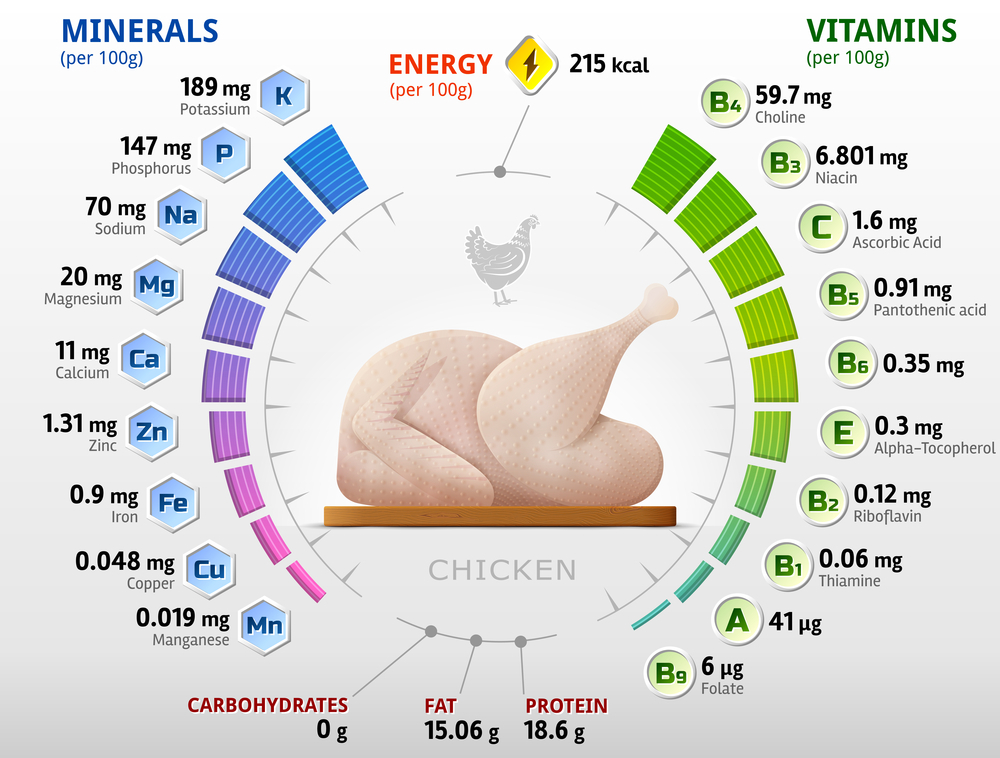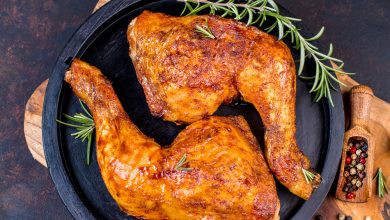Nourish Your Body: The Complete Guide to Chicken Nutrition Facts

Chicken stands as one of the most beloved and versatile protein sources worldwide, making its way into an array of dishes across different cuisines. Its popularity can be attributed not only to its mild flavor and adaptability in cooking but also to the wealth of nutritional benefits it offers. Packed with high-quality protein, essential vitamins, and minerals, chicken provides a host of health advantages, making it an excellent choice for individuals aiming to maintain a well-balanced diet.
In this comprehensive guide, we will explore everything there is to know about chicken nutrition. From the detailed nutritional profile of different cuts of chicken to the various health benefits it offers, we will leave no stone unturned. You will also learn about the impacts of different cooking methods on chicken’s nutritional value, common concerns related to chicken consumption, and more. By the end of this guide, we aim to equip you with all the knowledge you need to make informed decisions about including chicken in your diet, ensuring you reap the maximum nutritional benefits it has to offer.
Section 1: Nutritional Profile of Chicken
Chicken is renowned for its impressive nutritional profile, particularly its high protein content, which is vital for muscle growth and repair. A typical serving of chicken provides a substantial amount of lean protein, making it an excellent choice for those looking to build muscle or maintain a healthy weight.
Additionally, chicken is a rich source of essential vitamins and minerals such as Vitamin B6, Niacin (Vitamin B3), Phosphorus, and Selenium. Vitamin B6 plays a crucial role in brain development and function, while Niacin is important for converting food into energy and maintaining healthy skin.
Phosphorus is key for maintaining strong bones and teeth, and Selenium is an antioxidant that helps protect cells from damage. When compared to other protein sources like beef or pork, chicken often stands out due to its lower fat content and versatility in meal preparation, making it an accessible and nutritious option for a wide array of diets.
Section 2: Health Benefits of Eating Chicken
Incorporating chicken into your diet can yield numerous health benefits, making it a valuable addition to any meal plan. One of the most significant advantages of eating chicken is its high protein content, which is essential for muscle growth and repair. Whether you are an athlete looking to enhance your performance or someone recovering from an injury, the lean protein in chicken can help rebuild and maintain muscle tissue effectively.
Additionally, chicken plays a crucial role in weight management, as it is low in calories yet highly satisfying, helping to curb hunger and reduce overall calorie intake. Its lean nature also makes it a heart-healthy option, as it contributes to lower levels of bad cholesterol (LDL), reducing the risk of heart disease. Moreover, chicken is rich in vitamins and minerals that are pivotal for a robust immune system.
Nutrients like Vitamin B6 and Selenium help enhance your body’s defenses against illnesses, ensuring you stay healthy and active. Combining these benefits, it’s clear that including chicken in your diet can support your fitness goals, weight management efforts, cardiovascular health, and overall well-being.
Section 3: Different Cuts and Their Nutritional Differences
When it comes to choosing the right cut of chicken, understanding the nutritional differences can help you make informed dietary choices. Chicken breast is often celebrated for its high protein content and low-fat composition, making it a staple for those seeking lean muscle growth and maintenance while keeping their calorie intake in check.
In contrast, chicken thighs offer a balanced mix of protein and fats, providing a juicier and more flavorful option that still supports a nutrient-rich diet. Drumsticks strike a similar balance but are also noted for their distinctive flavor, making them a favorite in many households. Chicken wings, while popular as a snack or appetizer, tend to be higher in fats; they offer a tasty indulgence but should be enjoyed in moderation.
Finally, the skin of the chicken, although it adds a delectable crispness, is high in fat. While some choose to remove the skin to reduce fat intake, others prefer to leave it on for added flavor and texture. By understanding these differences, you can better tailor your chicken choices to meet your nutritional needs and taste preferences.
Section 4: Cooking Methods and Their Nutritional Impact
Selecting the right cooking method can significantly influence the nutritional value of your chicken dishes. Grilling chicken is known for creating a delicious, smoky flavor while keeping fat content low, as excess fats drip off during cooking.
In contrast, frying, especially in oil, can add considerable amounts of unhealthy fats and calories, which may offset some of the nutritional benefits of chicken. When it comes to baking vs. boiling, both methods have their merits.
Baking chicken allows you to preserve its natural flavors without adding excessive fats, while boiling can keep the meat tender and moist, although some nutrients may leach into the cooking water. To retain maximum nutritional value, consider marinating your chicken with herbs and spices instead of heavy sauces, and avoid overcooking, as this can lead to nutrient loss.
Additionally, opting for healthier oils like olive or avocado oil when grilling or baking can further enhance nutrient retention and overall health benefits. By carefully choosing your cooking methods, you can enjoy delicious chicken meals that are both flavorful and nutritious.
Section 5: Addressing Common Concerns
When it comes to incorporating chicken into your diet, several common concerns often emerge, particularly regarding cholesterol levels, antibiotic use in poultry farming, and the differences between organic and conventional chicken. Chicken is generally considered a healthier option compared to red meats, as it typically contains lower levels of saturated fats and LDL cholesterol.
However, the cholesterol content can vary across different cuts; for instance, chicken thighs and wings may have higher cholesterol levels compared to chicken breasts. Another significant concern is the use of antibiotics in poultry farming. Many consumers worry about antibiotic residues and the potential for antibiotic resistance. To address these worries, it’s vital to look for labels indicating “antibiotic-free” or “raised without antibiotics.”
Finally, the debate between organic and conventional chicken often hinges on health and environmental impacts. Organic chicken is raised without synthetic pesticides, fertilizers, antibiotics, or hormones and fed organic feed, which can result in higher prices but offer peace of mind regarding food safety and environmental responsibility. Understanding these factors can help you make choices that align with your health priorities and ethical considerations.
Conclusion
In conclusion, chicken stands out as a highly nutritious and versatile protein source that can greatly enhance your diet. Its high protein content supports muscle growth and repair, while its low-fat nature makes it a heart-healthy option. With essential vitamins and minerals like Vitamin B6 and Selenium, chicken also contributes to a strong immune system, helping to keep you healthy and active. Understanding the nutritional differences between various cuts, from lean chicken breast to flavorful thighs, allows for more tailored dietary choices that can meet your specific needs.
We encourage you to incorporate chicken into a balanced diet to reap these numerous health benefits. Whether you prefer grilling, baking, or boiling, the right cooking methods can help you maximize the nutritional value of your chicken dishes while keeping them delicious and satisfying.
We’d love to hear from you! Share your favorite chicken recipes, cooking tips, and personal experiences. Let’s create a community where we can learn from each other and continue to nourish our bodies the best way we can. Happy cooking!
Additional Resources
To help you further on your culinary and nutritional journey, we’ve compiled some valuable resources that align with the insights shared in this guide.
Links to Healthy Chicken Recipes
- Grilled Lemon Herb Chicken: This recipe offers a delicious, low-fat option that is bursting with flavor.
- Baked Garlic Parmesan Chicken: Enjoy a healthier take on a classic dish that balances taste with nutritional benefits.
- Spicy Chicken and Sweet Potatoes: A hearty and nutritious meal that pairs lean chicken breast with nutrient-rich sweet potatoes.
- Chicken and Vegetable Stir-Fry: Quick and easy, this stir-fry is loaded with vegetables and lean protein, perfect for any weeknight dinner.
Recommendations for Further Reading on Nutrition
To further expand your understanding of nutrition and how to maintain a well-rounded diet, consider these informative resources:
- Harvard T.H. Chan School of Public Health – Protein: An in-depth look at protein sources, including the benefits of incorporating chicken into your diet.
- Mayo Clinic – Nutrition and Healthy Eating: Offers a wealth of articles and tools to help you make informed dietary choices.
- The Academy of Nutrition and Dietetics: Provides evidence-based nutrition information and resources for maintaining a balanced diet.
Expert Opinions and Studies on Chicken Nutrition
- American Heart Association – Chicken and Meat: An exploration of how chicken fits into a heart-healthy diet, with tips from leading health experts.
- National Institutes of Health (NIH) Study on Poultry Consumption: Detailed research on the health impacts of poultry consumption, including its role in reducing the risk of cardiovascular diseases.
- Journal of Food Science and Technology – Nutritional Value of Chicken: Peer-reviewed studies on the nutrient composition of different chicken cuts and their health implications.
By leveraging these resources, you can continue to nourish your body with nutritious chicken dishes while staying informed about the latest nutritional insights and expert opinions. Happy cooking and continued health!




